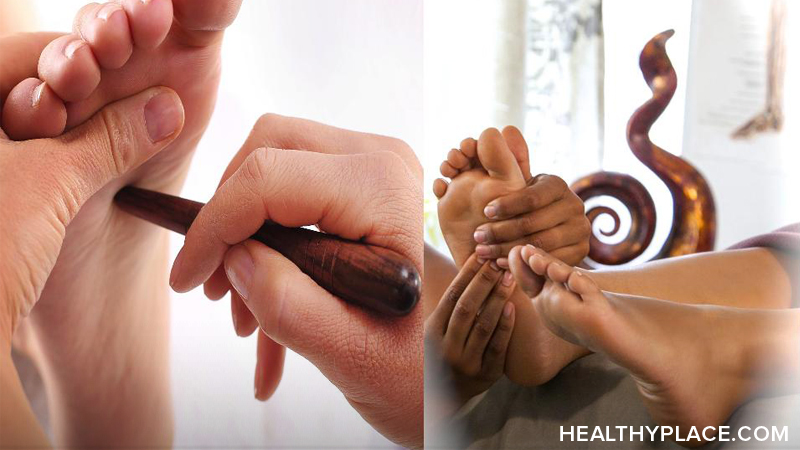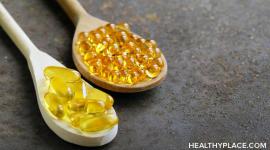Reflexology to Relieve Stress, Improve Health

Learn about reflexology, an alternative health technique said to improve stress, anxiety, chronic lower back pain, and other health issues.
Before engaging in any complementary medical technique, you should be aware that many of these techniques have not been evaluated in scientific studies. Often, only limited information is available about their safety and effectiveness. Each state and each discipline has its own rules about whether practitioners are required to be professionally licensed. If you plan to visit a practitioner, it is recommended that you choose one who is licensed by a recognized national organization and who abides by the organization's standards. It is always best to speak with your primary health care provider before starting any new therapeutic technique.
Background
Reflexology aims to relieve stress or treat health conditions through the application of pressure to specific points or areas of the feet. The underlying idea of reflexology is that areas of the feet correspond to (and affect) other parts of the body. In some cases, pressure may also be applied to the hands or ears.
Techniques similar to reflexology have been used for thousands of years in Egypt, China and other areas. In the early 20th century, an American physician named William Fitzgerald suggested that the foot could be "mapped" to other areas of the body to diagnose or treat medical conditions. He divided the body into 10 zones and labeled the parts of the foot that he believed controlled each zone. He proposed that gentle pressure on a particular area of the foot could generate relief in the targeted zone. This process was originally called zone therapy.
In the 1930s, Eunice Ingham, a nurse and physiotherapist, further developed these maps to include specific reflex points. At that time, zone therapy was renamed reflexology. Modern reflexologists in the United States often learn Ingham's method or a similar technique developed by the reflexologist Laura Norman.
Reflexology charts include pictures of the feet with diagrams of corresponding internal organs or parts of the body. The right side of the body is believed to be reflected in the right foot, and the left side, in the left foot. Different health care providers, such as massage therapists, chiropractors, podiatrists, physical therapists or nurses, may use reflexology.
Theory
Several theories have been put forward to explain the mechanism behind reflexology, although none has been scientifically proven. One proposal is that the body contains an invisible life force, or energy field, that when blocked can result in illness. It has been suggested that stimulation of the foot and nerves can unblock and increase the flow of vital energy to various parts of the body, promoting healing. Other theories include the release of endorphins (natural pain killers in the body), stimulation of nerve circuits in the body ("cutaneo-organ reflexes"), promotion of lymphatic flow or the dissolving of uric acid crystals.
When a client visits a reflexologist, a full medical history will often be taken before examination of the bare feet. Clients usually remain fully clothed during examination and treatment, sitting with the legs raised or lying on a treatment table. Practitioners begin with gentle massage of the feet, followed by pressure to selected reflex points. This therapy should never be painful.
Therapists may use lotion or oils for lubrication, sometimes including aromatherapy products. Occasionally, instruments are used on the feet, such as sticks of wood, clothespins, combs, rubber balls, rubber bands, tongue depressors, wire brushes, special massagers, hand probes or clamps. Some reflexology books note that clients may feel tingling in the part of the body corresponding to the reflex point being stimulated, although this has not been studied or documented scientifically.
Sessions often last from 30 to 60 minutes and may be part of a four- to eight-week course of therapy. Techniques can be learned and self-administered. There is no widely accepted regulatory system for reflexology, and there is no state licensure or training requirement in the United States at this time.
Evidence
Scientists have studied reflexology for the following health problems:
Relaxation, anxiety
Early evidence suggests that reflexology may be useful for relaxation, although it is not clear if reflexology is better than (or equal to) massage or other types of physical manipulation. Better research is needed to make a recommendation.
Premenstrual syndrome
Two months of weekly reflexology sessions may help reduce the severity of premenstrual symptoms in the short-term, according to early studies in humans. Further research is necessary to reach a firm conclusion.
Headache
Early research suggests that reflexology may relieve pain from migraine or tension headaches and that it may reduce the need for pain medication. However, study in this area has not been high quality, and better research is needed to reach a firm conclusion.
Irritable bowel syndrome, encopresis, constipation
Preliminary study of reflexology in humans with irritable bowel syndrome does not provide clear answers. One small, controlled clinical trial showed reflexology to be an effective method of treating encopresis (fecal incontinence) and constipation over a six-week period. Further research is needed to confirm these results.
Comfort and palliation in cancer patients
Early research reports that reflexology is no better than foot massage in palliative cancer care.
Chronic lower back pain
Preliminary evidence in humans suggests that reflexology is not helpful for chronic lower back pain. Better research is needed to make a firm conclusion.
Disease diagnosis
Preliminary research regarding reflexology techniques for diagnosing diseases is mixed. Better research is needed to clarify these results.
Ear disorders
A study in children with ear disorders receiving treatment from a reflexologist showed this treatment to be less effective (in terms of number of ear disorders, number of antibiotic treatments, number of sickness days, and duration of ear disorders) than treatment given by a general practitioner. Further studies are needed before conclusions can be drawn.
Fetal activity
A small study reported that foot massage for three minutes increased fetal activity in midgestation. Hand massage did not increase fetal activity. Further studies are needed before conclusions can be drawn.
Foot edema
Preliminary research reports that reflexology is a preferred therapy in women with ankle and foot edema in late pregnancy. Further research is needed before conclusions about effectiveness can be made.
Multiple sclerosis
Preliminary evidence suggests reflexology treatment may be beneficial in the management of some motor or sensory symptoms of multiple sclerosis. Additional research is needed to make a firm conclusion.
Cancer pain
Early evidence suggests foot reflexology may help manage some cancer pain. Better research is needed before a firm conclusion can be drawn.
Unproven Uses
Reflexology has been suggested for many other uses, based on tradition or on scientific theories. However, these uses have not been thoroughly studied in humans, and there is limited scientific evidence about safety or effectiveness. Some of these suggested uses are for conditions that are potentially life-threatening. Consult with a health care provider before using reflexology for any use.
| Abdominal pain Acne Alcoholism Arthritis Asthma Bedwetting Bladder control Bursitis Chronic fatigue syndrome Depression Developmental care (preterm infants) Diabetes Digestive disorders Eczema Elimination of blood toxins Fatigue Fibromyalgia General pain management Glandular disorders Gum inflammation Gynecologic disorders | High blood pressure Improved blood supply Insomnia Intestinal disorders Kidney stones Liver disease Neck pain Neck stiffness Noncardiac chest pain Pancreatic disorders Paralysis Postmenopausal symptoms Postoperative nausea and vomiting "Restoration" of homeostasis Sciatica Shingles (herpes zoster and post-herpetic neuralgia) Sinusitis Spine problems Stress-related disorders Whiplash |
Potential Dangers
People with recent or healing fractures, unhealed wounds or active gout affecting the foot should avoid reflexology. If you have osteoarthritis affecting the ankle or foot or severe circulation problems in the legs or feet, seek medical consultation before starting reflexology.
Some reflexology books list conditions that theoretically may be negatively affected by this therapy, although scientific information is limited. Examples include diabetes, heart disease or the presence of a pacemaker, unstable blood pressure, cancer, active infections, past episodes of fainting (syncope), mental illness, gallstones or kidney stones. Caution is advised in pregnant women, based on reports that rigorous stimulation of the feet may cause contractions of the uterus.
Reflexology should not delay diagnosis or treatment with more proven techniques or therapies.
Summary
Reflexology has been suggested for many health conditions, but there is little scientific study available regarding the effectiveness or safety of this technique. People with recent injuries to the foot should avoid reflexology. Preliminary research suggests that reflexology may not be as effective as other therapies for diagnosing diseases. It is not recommended to rely on reflexology alone to treat potentially dangerous medical conditions. Speak with your health care provider if you are considering the use of reflexology.
The information in this monograph was prepared by the professional staff at Natural Standard, based on thorough systematic review of scientific evidence. The material was reviewed by the Faculty of the Harvard Medical School with final editing approved by Natural Standard.
Resources
- Natural Standard: An organization that produces scientifically based reviews of complementary and alternative medicine (CAM) topics
- National Center for Complementary and Alternative Medicine (NCCAM): A division of the U.S. Department of Health & Human Services dedicated to research
Selected Scientific Studies: Reflexology
Natural Standard reviewed more than 200 articles to prepare the professional monograph from which this version was created.
Some of the more recent studies are listed below:
- Beachy JM. Premature infant massage in the NICU. Neonatal Netw 2003;May-Jun, 22(3):39-45.
- Benchimol M, de Oliveira-Souza R. [Syncope in the elderly: diagnostic utility of carotid sinus massage in head-up tilt test.][Article in Portuguese] Arq Neuropsiquiatr 2003;Mar, 61(1):87-90.
- Epub 2003;Apr 16. Beurskens CH, Heymans PG. Positive effects of mime therapy on sequelae of facial paralysis: stiffness, lip mobility, and social and physical aspects of facial disability. Otol Neurotol 2003;Jul, 24(4):677-681.
- Bishop E, McKinnon E, Weir E, Brown DW. Reflexology in the management of encopresis and chronic constipation. Paediatr Nurs 2003;Apr, 15(3):20-21.
- Botting D. Review of the literature on the effectiveness of reflexology. Complement Ther Nurs Midwifery 1997;3(5):123-130.
- Brygge T, Heinig JH, Collins P, et al. Reflexology and bronchial asthma. Respir Med 2001;95(3):173-179.
- Diego MA, Dieter JN, Field T, et al. Fetal activity following stimulation of the mother's abdomen, feet, and hands. Dev Psychobiol 2002;Dec, 41(4):396-406.
- Ernst E, Koder K. An overview of reflexology. Eur J Gen Practice 1997; 3:52-57.
- Evans SL, Nokes LDM, Weaver P, et al. Effect of reflexology treatment on recovery after total knee replacement. J Bone Joint Surg Br 1998;80(Suppl 2):172.
- Fassoulaki A, Paraskeva A, Patris K, et al. Pressure applied on extra 1 acupuncture point reduces bispectral index values and stress in volunteers. Anesth Analg 2003; Mar, ;96(3):885-890, Table of Ccontents. Comment in Anesth Analg 2003;Sep, 97(3):925. Author reply, 925-926.
- Fellowes D, Gambles M, Lockhart-Wood K, et al. Reflexology for symptom relief in patients with cancer. Cochrane Database of Systematic Reviews 2002, Vol 2 (Date of most recent substantive update: September 22, 1999).
- Guzzetta C, Jonas WB. Randomized controlled study of premenstrual symptoms treated with ear, hand, and foot reflexology. Altern Ther Health Med 1995;1(1):78-79.
- Haynes G, Garske D, Case D, et al. Effect of massage technique on sentinel lymph node mapping for cancer of the breast. Am Surg 2003;Jun, 69(6):520-522.
- Hodgson H. Does reflexology impact on cancer patients' quality of life? Nurs Stand 2000;14(31):33-38.
- Kjoller M. [Children with ear disorders who are treated by reflexologists or general practitioners.] [Article in Danish] Ugeskr Laeger 2003;May 5, 165(19):1994-1999.
- Kober A, Scheck T, Schubert B, et al. Auricular acupressure as a treatment for anxiety in prehospital transport settings. Anesthesiology 2003;Jun, 98(6):1328-1332.
- Launso L, Brendstrup E, Arnberg S. An exploratory study of reflexological treatment for headache. Altern Ther Health Med 1999;5(3):57-65.
- Mollart L. Single-blind trial addressing the differential effects of two reflexology techniques versus rest, on ankle and foot oedema in late pregnancy. Complement Ther Nurs Midwifery 2003;9(4):203-208.
- Oleson T, Flocco W. Randomized controlled study of premenstrual symptoms treated with ear, hand, and foot reflexology. Obstet Gynecol 1993;82(6):906-911.
- Poole H, Murphy P, Glenn S. Evaluating the efficacy of reflexology for the management of chronic low back pain. 8th Annual Symposium on Complementary Health Care, Exeter, England, December 6-8, 2001.
- Raz I, Rosengarten Y, Carasso R. [Correlation ostudy between conventional medical diagnosis and the diagnosis by reflexology (non conventional)]. Harefuah 2003;142(8-9):600-605, 646.
- Ross CS, Hamilton J, Macrae G, et al. A pilot study to evaluate the effect of reflexology on mood and symptom rating of advanced cancer patients. Palliat Med 2002;Nov, 16(6):544-545.
- Siev-Ner I, Gamus D, Lerner-Geva L, et al. Reflexology treatment relieves symptoms of multiple sclerosis: a randomized controlled study. Mult Scler 2003;9(4):356-361.
- Stephenson N, Dalton JA, Carlson J. The effect of foot reflexology on pain in patients with metastatic cancer. Appl Nurs Res 2003;16(4):284-286.
- Stephenson NL, Dalton JA. Using reflexology for pain management: a review. J Holist Nurs 2003;Jun, 21(2):179-191.
- Stephenson NL, Weinrich SP, Tavakoli AS. The effects of foot reflexology on anxiety and pain in patients with breast and lung cancer. Oncol Nurs Forum 2000;27(1):67-72.
- Tovey P. A single-blind trial of reflexology for irritable bowel syndrome. Br J Gen Pract 2002;52(474):19-23.
- White AR, Williamson J, Hart A, et al. A blinded investigation into the accuracy of reflexology charts. Complement Ther Med 2000;8(3):166-172.
back to: Alternative Medicine Home ~ Alternative Medicine Treatments
APA Reference
Staff, H.
(2008, December 1). Reflexology to Relieve Stress, Improve Health, HealthyPlace. Retrieved
on 2025, November 29 from https://www.healthyplace.com/alternative-mental-health/treatments/reflexology-to-relieve-stress


